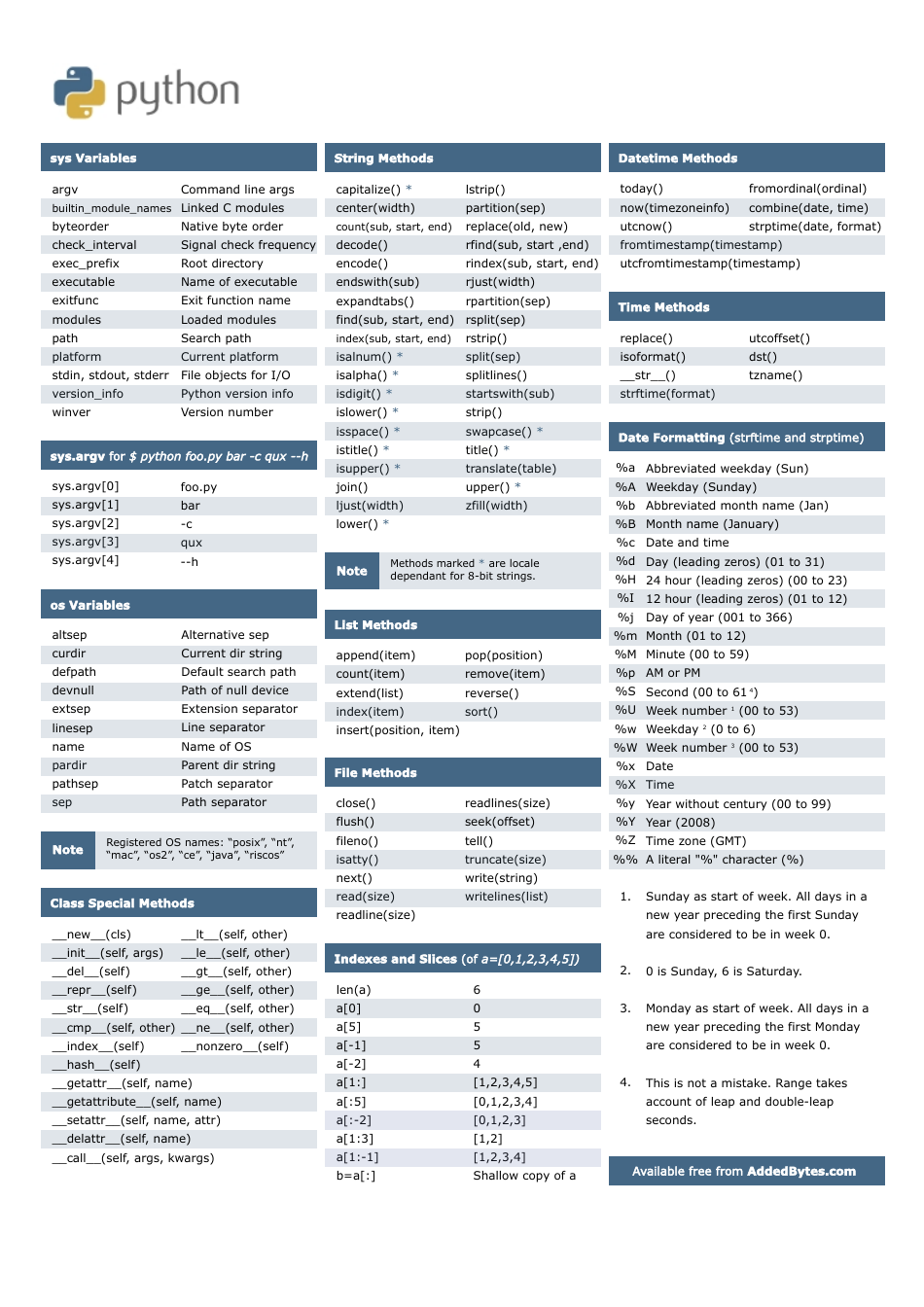From Learn Python the Hardway by Zed Shaw
(expanded from Lesson 22)
Character / Command * What it's called * What it does * example * example2
Python for Beginners –Cheat Sheet Data types and Collections i nt eger 10 fl o a t 3.14 b o o l ea n True/False s t ri ng ‘abcde’ l i s t 1, 2, 3, 4, 5. Python Cheat Sheet 1. Strings are used quite often in Python. Strings, are just that, a string of characters. You can also format strings with the. Learn about Python operators, Python data types, and Python functions, which are all important parts of this flexible programming language.
pydoc <something> # pydoc gives you the manual page for something you want to know about in python pydoc sys
help() # help function use when running python to find help on an object
print() # print function prints to the console whatever is next print(“Hello World!”) print(1 + 2)
' ' # double quotes starts and ends a string print(“Hello World!”)

' ' # single quotes starts and ends a string print('Hello World!')
= # equals assigns values to a variable or function count = 10 i, j, k, numbers = initialize()
# pound comment; blocks out the line from being read by the interpreter # This is a comment and won't do anything
; # semi-colon let's you separate multiple lines of code on one line from sys import argv; from os.path import exists; script, from_file, to_file = argv
: # colon used for defining things like in functions; tells python you are going to create a new 'block' of code' followed by a new line with 4 indented spaces and then code. def some_function():
, # comma separates strings from variables print 'The script is called:', script
- # plus adds 2+2 equals 4
- # minus subtracts etc.
/ # slash divides, allows you to continue a line of code on multiple lines etc.
- # asterik multiplies, wild card from ex25 import *
% # 1. percent gives the remainder of a divisor 7 % 6 returns 1
% # 2. String Fornatter converts something to something in a string http://docs.python.org/2/library/stdtypes.html#string-formatting-operations
'%d, %r, %s # escape characters let's you insert the contents of a variable into a string. %d is for display, %r is for debugging, %s is for inserting / converting to a string. there are others as well... print 'You have this many %d potatoes.' % potatoes
( ) # paranthesis for multiple escape character variables, functions print('Some string {0} {1}'.format(variable1, variable2)) some_function()
< # greater than comparison operator if buses > cars: print 'Too many buses.'
> # less than comparison operator
<= # greater than or equal to comparison operator
>= # less than or equal to comparison operator
# is equal to comparison operator
!= # does not equal comparison operator
_ # underscore charcter generally used instead of spaces number_passengers
# backslash let's you 'escape' certain characters in python print 'I have a 'stupid' cat.' print 'I am 5'8' tall.'
n # newline character (backslash n) inserts a new line
t # tab inserts a tab print('' I'll do a list: nt*beer nt*chips nt*salsa '')
'' # triple double quotes lets you type a comment on mulitple lines, as long as you have '' at the begining and end
''This is some code that does blah blah blah''
raw_input() # raw input (built in function) takes input in the form a string from the user you can prompt the user by doing
: raw_input('user give me some data') var = raw_input('> ')
input() # input function (built in) takes input in the form of a integer from the user age = input('What's your age? ')
import # import statement adds native python modules from sys import argv
sys # sys module provides access to some objects used or maintained by the interpreter and to functions that interact
strongly with the interpreter from sys import argv
argv # argument variable see pydoc sys script, filename = argv
os.path # path module
exists # exists command returns true / false if a file exists or not
int() # convert to integer function takes a number and makes it an integer int(3.33) would return 3
float() # convert to a floating point number ' makes it a float float(3) would return 3.0
open() # open function built in function for opening files text = open(some_file)
read() # read function reads the contents of the script. see pydoc file print(text.read())
close() # close function closes the file text.close()
write(stuff) # write function writes stuff to the file text.write(stuff)
truncate() # truncate function empties the file text.truncate()
seek() # seek takes you to specific line in a file def rewind(f): f.seek(0)
range() # range adds a range of integers to a list. range(1,6) will return 0, 1, 2, 3, 4, 5. You can also specify the step inthe 3rd number eg: range(1,6,2) will return 0, 2, 4 <<<
append() #append appends object(s) to the end of the list
. # period, dot *lets you call functions on variables or string connect multiple functions: open(to_file, 'w').write(indata) OR output.close()
def # define *defines a function: def this_function(some_parameter):
return # return *returns something to the console from within a funciton
[ ] # brackets *for containing lists fruit = ['apples', 'oranges', bananas'] coins = [1, 5, 10, 25]
Do you want to learn Python but you’re overwhelmed and you don’t know where to start? Learn with Python cheat sheets! They compress the most important information in an easy-to-digest 1-page format.
Here’s the new Python cheat sheet I just created—my goal was to make it the world’s most concise Python cheat sheet!
Python Cheat Sheet Download
While working as a researcher in distributed systems, Dr. Christian Mayer found his love for teaching computer science students.
To help students reach higher levels of Python success, he founded the programming education website Finxter.com. He’s author of the popular programming book Python One-Liners (NoStarch 2020), coauthor of the Coffee Break Python series of self-published books, computer science enthusiast, freelancer, and owner of one of the top 10 largest Python blogs worldwide.
Python Cheat Sheet Pdf
His passions are writing, reading, and coding. But his greatest passion is to serve aspiring coders through Finxter and help them to boost their skills. You can join his free email academy here.
All Python Format Characters
Related Posts
